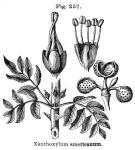
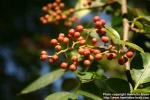 Preparations: Fluid Extract of Xanthoxylum
- Compound Powder of Xanthoxylum
- Tincture of Xanthoxylum
- Oleoresin of Xanthoxylum
Preparations: Fluid Extract of Xanthoxylum
- Compound Powder of Xanthoxylum
- Tincture of Xanthoxylum
- Oleoresin of Xanthoxylum
The bark of Xanthoxylum americanum, Miller (X. fraxineum, Willdenow; X. fraxinifolium, Marshall; X. ramiflorum, Michaux; X. tricarpum, Hooker; X. Clava-Herculis, Lamarck; Thylax fraxineum, Rafinesque), and of Xanthoxylum Clava-Herculis, Linné (X. fraxinifolium, Walter; X. aromaticum, Willdenow; X. carolinianum, Lamarck; X. tricarpum, Michaux; X. Catesbianum, or Pseudopetalon glandulosum, or P. tricarpum, Kampmannia fraxinifolia, Rafinesque; Fagara fraxinifolia, Lamarck). The berries are also employed, but are not official.
Nat. Ord.—Rutaceae.
COMMON NAMES: (1) Prickly ash, Toothache tree (or bush), Northern prickly ash, Yellow wood, Angelica tree, Suterberry; (2) Southern prickly ash, Toothache tree, Angelica tree, Suterberry.
ILLUSTRATIONS: (1) Bigelow, Amer. Med. Bot., Vol. III, 156; (2) Willdenow, Sp. Plant., Vol. IV, 214.
Botanical Source.—Xanthoxylum americanum is an indigenous shrub, 10 or 12 feet in height, with alternate branches, which are armed with strong, conical, brown prickles, with a broad base, scattered irregularly, though most frequentlyin pairs at the insertion of the young branches. The leaves are alternate and pinnate; the leaflets about 5 pairs, with an odd one, nearly sessile, ovate, acute, with slight vesicular serratures, and somewhat downy underneath; the common petiole round, usually prickly on the back, though sometimes unarmed. The flowers are borne in small, dense, sessile umbels, near the origin of the young branches; they are small, greenish, dioecious or polygamous, appear before the leaves, and have a somewhat aromatic odor. In the sterile flower the calyx is 5-leaved, with oblong, obtuse, erect segments, 5 stamens with subulate filaments, and sagittate, 4-celled anthers; the ovary is abortive. In the hermaphrodite or perfect flower, the calyx and stamens are like the last, ovaries 3 to 4, pediceled, with erect, converging styles nearly as long as the stamens. Fertile or female flowers grow upon a separate tree, are apetalous, with a smaller and more compressed calyx, and 5 pediceled ovaries, with styles converging into close contact at top, and a little twisted; stigmas obtuse. Each fertile flower is succeeded by as many capsules as it had ovaries. Capsules stipitate, oval, covered with excavated dots, varying from green to red; 2-valved and 1-seeded; seeds oval and blackish (L-W.—G.).
Xanthoxylum Clava-Herculis ranges from a shrub to a small-sized tree, yet sometimes attaining a height of 45 feet. The bark is beset with verrucose prickles. The petioles and branches are armed with larger prickles. The leaves are odd-pinnate; the leaflets from 5 to 17 in number, ovate-lanceolate, unequilateral, the terminal one only being equilateral, shining and smooth on the upper surface, and having crenate-serrulate margins. The flowers are plentiful, of a greenish hue, appear before the leaves, and have but 3 pistils.
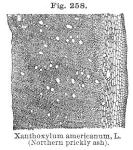 History.—Northern prickly ash, a well-known shrub of the rue family, furnishes a drug that ranked among the most important during the early investigations of our indigenous remedies by the "Eclectic Fathers." It was an especial favorite with Prof. John King. The shrub is common in thickets, rocky woods, and along river banks from Virginia northward to Canada, and westward to the Mississippi, though scarce east of the Hudson valley. It grows to the height of 5 to 10 feet. The flowers, which appear in April and May before the leaves have expanded, are axillary, small, and of a greenish color. On account of its pinnate leaves and spiny, prickly stems, it is best known to the common people as Prickly ash. To distinguish it from a southern species (Xanthoxylum Clava-Herculis), which is known as Southern prickly ash, it is sometimes called Northern prickly ash. Its reputed efficacy in toothache has given it the name of Toothache tree. In common with some other plants, it is also known as Yellow wood, a name giving the literal meaning of Xanthoxylum (Greek: xanthos, yellow; xylon, wood). All parts of the shrub are aromatic and pungent, and the leaves and berries have a decided odor of lemons. Water and alcohol extract its virtues. The therapeutic principle of the berries resides in the capsule surrounding the seeds. This principle has been found to be a volatile oil. The whole plant possesses medicinal virtues; the fragrance of the fruit and leaves is due to a volatile oil. Both the bark and fruit (berries) are employed medicinally.
History.—Northern prickly ash, a well-known shrub of the rue family, furnishes a drug that ranked among the most important during the early investigations of our indigenous remedies by the "Eclectic Fathers." It was an especial favorite with Prof. John King. The shrub is common in thickets, rocky woods, and along river banks from Virginia northward to Canada, and westward to the Mississippi, though scarce east of the Hudson valley. It grows to the height of 5 to 10 feet. The flowers, which appear in April and May before the leaves have expanded, are axillary, small, and of a greenish color. On account of its pinnate leaves and spiny, prickly stems, it is best known to the common people as Prickly ash. To distinguish it from a southern species (Xanthoxylum Clava-Herculis), which is known as Southern prickly ash, it is sometimes called Northern prickly ash. Its reputed efficacy in toothache has given it the name of Toothache tree. In common with some other plants, it is also known as Yellow wood, a name giving the literal meaning of Xanthoxylum (Greek: xanthos, yellow; xylon, wood). All parts of the shrub are aromatic and pungent, and the leaves and berries have a decided odor of lemons. Water and alcohol extract its virtues. The therapeutic principle of the berries resides in the capsule surrounding the seeds. This principle has been found to be a volatile oil. The whole plant possesses medicinal virtues; the fragrance of the fruit and leaves is due to a volatile oil. Both the bark and fruit (berries) are employed medicinally.
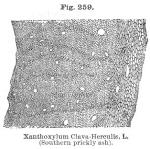 Description.—BARK. The two official barks are thus described: "Xanthoxylum americanum (Northern prickly ash) is in curved or quilled fragments, about 1 Mm. (1/25 inch) thick; outer surface brownish-gray, with whitish patches, and minute, black dots, faintly furrowed, with some brown, glossy, straight, 2-edged spines, linear at the base, and about 5 Mm. (⅕ inch) long; inner surface whitish, smooth; fracture short, non-fibrous, green in the outer and yellowish in the inner layer; inodorous; taste bitterish, very pungent. Xanthoxylum Clava-Herculis (Southern prickly ash) resembles the preceding, but is about 2 Mm. (1/12 inch) thick, and is marked by many conical, corky projections, sometimes 2 Cm. (⅘ inch) high, and by stout, brown spines, rising from a corky base. Xanthoxylum should not be confounded with the bark of Aralia spinosa, Linné (Nat. Ord.—Araliaceae), which is nearly smooth externally, and beset with slender prickles in transverse rows"—(U. S. P.).
Description.—BARK. The two official barks are thus described: "Xanthoxylum americanum (Northern prickly ash) is in curved or quilled fragments, about 1 Mm. (1/25 inch) thick; outer surface brownish-gray, with whitish patches, and minute, black dots, faintly furrowed, with some brown, glossy, straight, 2-edged spines, linear at the base, and about 5 Mm. (⅕ inch) long; inner surface whitish, smooth; fracture short, non-fibrous, green in the outer and yellowish in the inner layer; inodorous; taste bitterish, very pungent. Xanthoxylum Clava-Herculis (Southern prickly ash) resembles the preceding, but is about 2 Mm. (1/12 inch) thick, and is marked by many conical, corky projections, sometimes 2 Cm. (⅘ inch) high, and by stout, brown spines, rising from a corky base. Xanthoxylum should not be confounded with the bark of Aralia spinosa, Linné (Nat. Ord.—Araliaceae), which is nearly smooth externally, and beset with slender prickles in transverse rows"—(U. S. P.).
BERRIES.—The fruit, or berries, as met with in commerce, consist of open, bivalved, oval capsules, about 3 lines in length and 2 in diameter, brownish, and covered with excavated dots externally, whitish-yellow, and smooth internally, and usually with a portion of the stalk appended; they inclose an oval, shining, black, wrinkled seed, which, in the dried state, is hollow, and grayish-yellow or light brownish-yellow internally, inodorous, very brittle, and having the peculiar taste of the capsule in a very faint degree. This seed is more often absent than present in the capsule, from whose opening it escapes, and may be generally found separated from it, but mixed up with the mass. The medicinal virtues of the fruit reside in the capsules, which have a faintly aromatic, peculiar odor, and a warm, pungent, peculiar, aromatic, and pleasant taste, both of which properties are more energetic in the recent than in the dried fruit. They depend upon a volatile oil for their properties, which they yield to alcohol or ether.
Chemical Composition.—The bark of Xanthoxylum fraxineum, Willdenow, (Northern prickly ash) was first investigated by Dr. Edward Staples (Amer. Jour. Pharm., 1829, p. 163), who isolated therefrom a crystallizable principle, which be called xanthoxylin. From the same source, E. T. Moffit (ibid., 1886, p. 417) and, previously, J. U. Lloyd (ibid., 1876, p. 226, and 1890, p. 229) obtained a similar substance. It forms colorless, tasteless needles, insoluble in cold water, very slightly soluble in boiling water, quite soluble in boiling alcohol; it is physiologically inert (Lloyd). A similar principle was derived from the bark of X. carolinianum (Southern prickly ash) by George H. Colton (ibid., 1880, p. 191). G. Eberhardt (ibid., 1890, p. 231) showed the non-identity of the principles derived from different species, while those obtained by various authors, from the same species, were shown to be identical. Probably the xanthoxyloïne of Witte (Dissert., 1876; see Jahresb. der Pharm., 1877, p. 178) is identical with the xanthoxylin of Staples, Lloyd, and Moffit. Witte found it to have the formula C14H14O2, and to melt between 131° and 131.5° C. (267.8° and 268.7° F.). Eberhardt observed a melting point of 129.5° C. (265.1° F.) with Lloyd's recrystallized specimen. According to Moffit (loc. cit.), the bark also contains a bitter, yellowish alkaloid, soluble in alcohol, water, and chloroform, insoluble in benzin and ether. It is probably related to berberine; a similar alkaloid, insoluble in chloroform, was found by Colton (loc. cit.) in northern bark. Additional constituents are fixed oil, an acrid resin, some sugar, tannin, gum, albuminoids, coloring matter, forming a precipitate with basic lead acetate, ash (about 12 per cent), but no starch (Moffit). In the Caribbean Xanthoxylum (Xanthoxylum carribaeum, Lamarck) Chevallier and Pelletan (1826) found the alkaloid xanthopicrite, which Perrins (1862) showed to be identical with berberine. In recent years Prof. Sebaer (Beiträge zur Geschichte des Berberins, Zürich, 1893) again demonstrated the presence of berberine in certain South American Xanthoxylum barks.
Action, Medical Uses, and Dosage.—Physiologically, prickly ash acts upon the secretions, the nervous and circulator systems. The bark, when chewed, imparts an aromatic, sweetish taste, followed by bitterness and persistent acridity. Its sialagogue properties are remarkable, inducing a copious flow of saliva, together with a great quantity of mucus from the buccal glands. This is brought about both by its local and systemic action. In the stomach it creates a sense of warmth, and the flow of both gastric and intestinal juices is augmented. There is increased biliary and pancreatic activity. Under its action the kidneys become more active, and an increased urinary product results. Cardiac action is increased, the pulse becomes slightly accelerated, and the integumentary glands give out an abundant secretion. Therapeutically, the bark is sialagogue, alterative, diaphoretic, and especially stimulant to the mucous surfaces. It is also emmenagogue and carminative, and the berries are said to possess antiseptic properties. To increase its diaphoretic power, it should be administered with plenty of hot water, at the same time subjecting the patient to a warm foot-bath. Prof. King cautions us that there is a material difference, in their influence on the system, between the tincture of the bark, or that of the berries, which should always be kept in view. The properties of the bark, as given by him, are stimulant, tonic, alterative, and sialagogue; of the berries, stimulant, carminative, and antispasmodic, acting especially on mucous tissues. Prickly ash has been deservedly valued in domestic practice as a remedy for chronic rheumatism, and was once quite popular as a masticatory for the relief of toothache. It undoubtedly has some value in rheumatic complaints, and may be combined with phytolacca when the indications for that drug are present. Its value in chronic rheumatism is very likely due to its eliminative power. It is best adapted to debilitated patients, and to cases of transient and fugitive forms of rheumatism, particularly lumbago, torticollis, myalgia, and muscular rheumatism. It may be used externally and administered internally, and in many cases will assist the action of macrotys. Its use in odontalgia will be confined to those cases where there is dull, grumbling pain due to peridental inflammation, the parts being dry and shining, and the buccal secretions scanty. Owing to its eliminative powers, it has been quite extensively used in constitutional syphilis and scrofula, and as a remedy for the former ranks with guaiac, stillingia, sarsaparilla, and mezereon. It is one of the constituents of "Trifolium Compound," and other alterative mixtures. Prof. King states that "combined with equal parts of pulverized blue flag and mandrake, it will bring on salivation, and is useful on this account in the treatment of scrofulous, syphilitic, and other diseases where there is a want of susceptibility to the influence of other alterative agents; the mixture must be given in small doses, and repeated at short intervals. Externally, it forms an excellent stimulating application to indolent and malignant ulcers." Xanthoxylum is serviceable in many disorders of the mouth and throat, as well as of the entire alimentary tract. It has some reputation as a local stimulant for paralysis of the tongue, though its value here is overrated. In like manner it has been employed in neuralgia, and paralytic conditions of the vocal apparatus and organs of deglutition. That it will relieve an unpleasant dryness of the mouth and fauces is well established. It is a remedy of value in pharyngitis, especially the chronic variety, the mucous surfaces presenting a glazed, shining, dry condition, with thin, adherent scales of dried mucus. In both pharyngitis and post-nasal catarrh a decoction locally, and specific xanthoxylum (bark) internally, will be found to aid a cure in those cases having dryness of mucous membranes as a distinctive feature. Prickly ash is unmistakably an admirable gastro-intestinal tonic. It will find a place in the treatment of atonic dyspepsia and gastric catarrh. Many chronic affections of the mucous tissues are benefited by it, the cases being those of enfeeblement and relaxation, with hypersecretion. Constipation due to deficient intestinal secretion has been overcome by its use alone. It is more especially indicated when accompanied by a flatulent distension of the abdomen. As an agent for flatulence, the preparation from the berries will give the best results. Lack of secretion in any part of the intestinal tract calls for a preparation of prickly ash bark. Both the bark and the berries may be required in some instances. Icterus, the result of biliary catarrh, is specifically influenced by xanthoxylum, as well as that form resulting from malarial impression. In spasm of the bowels, colic, cholera infantum, and cholera morbus, specific xanthoxylum (berries) will be found valuable in atonic cases. It is useful to restore the bowels to their normal state after severe attacks of dysentery, and has been of particular service as a remedy for epidemic dysentery. Prof. John King introduced the saturated tincture of the berries to the profession in Cincinnati, in 1849, as a remedy for Asiatic cholera. In his article on prickly ash berries in the College Journal for 1856 (p. 86), he writes: "I have used this tincture for some years past, and had the pleasure to introduce it to the profession in this city during the year 1849, both in the treatment of tympanitic distension of the bowels during peritoneal inflammation and in Asiatic cholera. In tympanites it may be administered by mouth and by injection; internally, from ½ to 1 fluid drachm may be given in a little sweetened water, repeating the dose every ½ or 1 hour. At the same time, ½ fluid ounce may be added to the same quantity of water and used as an injection, repeating it every 15 or 30 minutes, according to its influence and the severity of the symptoms, and should there be pain 10 to 20 drops of laudanum may be added to every third or fourth injection. The action is usually prompt and permanent, and, as far as my experience has gone, I prefer it, in a majority of cases, to oil of turpentine and other remedies advised in this condition. In Asiatic cholera during 1849-50 it was much employed by our physicians in Cincinnati, and with great success—it acted like electricity, so sudden and diffusive was its influence over the system. In this disease the tincture was given in teaspoonful doses, and repeated, according to circumstances, every 5, 10 or 20 minutes, at the same time administering an injection, prepared as above, after each discharge from the bowels, and causing it to be retained by the bowels as long as possible." Prof. King likewise valued it in atonic diarrhoea and in typhoid conditions requiring a stimulant, believing it to have an advantage over all other drugs for that purpose. In the tympanitic conditions incident to cholera infantum and other forms of diarrhoea, he combined equal parts of olive oil and tincture of prickly ash berries and had the little patient's abdomen freely rubbed with it, in a downward direction only, for 1 or 2 hours, until the flatulent state was over, claiming thereby to have saved many a little one who would otherwise have gone to an early grave. To prevent a return of the tympanitic distension he used the tincture by mouth and per rectum. Combined with diuretics and tonics, prickly ash has been employed in dropsy and in malarial manifestations, and is in good repute as a remedy for functional dysmenorrhoea. For the latter purpose about 20 drops of specific xanthoxylum (bark) should be administered at a dose, and repeated as often as necessary. Both the bark and berries give good results in neuralgic dysmenorrhoea with marked pain and hypersensitiveness. Xanthoxylum is a valuable nerve stimulant, and may be administered for some length of time without ill effects. It is valuable in all cases of prostration, and has been recommended in "hemiplegia, locomotor ataxia, and all depressed conditions of the vital forces." Pains down the anterior portions of the thighs, as well as after-pains, accompanied with dorsal or sacral pain, are relieved by it. It relieves neuralgic pains in anemic and delicate persons. Owing to its action on blood stasis, overcoming capillary engorgement, it has been found useful in determining the rash to the surface in the eruptive diseases, and is especially serviceable in cases of retrocession of the eruption. It is a remedy that is neglected, but should be borne in mind during the prevalence of summer diseases. The dose of specific xanthoxylum (berries) is from 5 to 30 drops; of specific xanthoxylum (bark), from 2 to 20 drops; of the powder, from 10 to 30 grains, 3 times a day. The oil of xanthoxylum may be used for the same purpose as the berries, in doses of from 2 to 10 drops, in mucilage, or on sugar; and its tincture, made according to the formula below (see Preparation), may be administered in the same doses as the tincture of the berries.
Specific Indications and Uses.—Xanthoxylum is specifically indicated (in the smaller doses) in hypersecretion from debility and relaxation of mucous tissues; atonicity of the nervous system (larger doses); in capillary engorgement in the exanthemata, sluggish circulation, tympanites in bowel complaints, intestinal and gastric torpor (with deficient secretion), dryness of the mucous membrane of mouth and fauces (with glazed, glossy surfaces), flatulent colic, Asiatic cholera, uterine cramps, and neuralgia. For the painful bowel disorders, the preparations of the berries are to be preferred.
Preparation.—An ethereal oil has been made from the bark, by filtering its ethereal tincture, and then evaporating or distilling off the ether. The oil is dark greenish-black in bulk, yellowish-green in thin layers; very fluid, possessing an odor of ether, and the peculiar taste of the bark in an eminent degree. It is soluble in alcohol, ether, and alkaline solutions, and will probably be found to possess the active principle of the bark in a concentrated form.
Related Species.—Xanthoxylum floridanum, Nuttall (probably identical with Lamarck's X. carribaeum), Yellow thorn, Yellow Hercules' club, Satin wood. Florida and West Indies. Yields a paralyzing and lethal alkaloid.
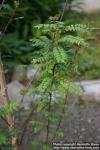 Xanthoxylum piperitum, De Candolle, of Japan, X. alatum, Roxburgh, of north India, and other species, yield aromatic, pungent berries, employed as condiments. They are also used as bitters and aromatics (Dymock). Stenhouse (1854 and 1857) distilled the fruits with water, and obtained an essential oil. The yield is over 3 per cent, and chiefly contains the aldehyde, citral (Schimmel & Co., October, 1890). The oil separates into crystals of a stearopten, called, by Stenhouse, xanthoxylin (C20H24O8), and a colorless liquid, xanthoxylene (C10H16), which boils at near 162° C. (324° F.). It is a hydrocarbon, perhaps identical with pinene or camphene.
Xanthoxylum piperitum, De Candolle, of Japan, X. alatum, Roxburgh, of north India, and other species, yield aromatic, pungent berries, employed as condiments. They are also used as bitters and aromatics (Dymock). Stenhouse (1854 and 1857) distilled the fruits with water, and obtained an essential oil. The yield is over 3 per cent, and chiefly contains the aldehyde, citral (Schimmel & Co., October, 1890). The oil separates into crystals of a stearopten, called, by Stenhouse, xanthoxylin (C20H24O8), and a colorless liquid, xanthoxylene (C10H16), which boils at near 162° C. (324° F.). It is a hydrocarbon, perhaps identical with pinene or camphene.
Xanthoxylum senegalense, Artar root.—Giacosa and Soave (Amer. Jour. Pharm., 1890, p. 500) have examined this root, and find, besides a fixed oil and a crystalline, neutral compound, two alkaloids—amorphous artarine (0.4 per cent), agreeing in composition with methyl hydroberberine (C21H23NO4); the second, a blood-red alkaloid is present in smaller quantity, and forms acicular crystals, readily soluble in water. One of the alkaloids is a cardiac stimulant, resembling veratrine in its action.
Xanthoxylum pterota, Kunth.—Southern United States, south to Brazil. Yields pungent leaves and bark, and has a hard, dense-yellow wood.
Xanthoxylum Naranjillo is said to resemble jaborandi, as a sialagogue, diuretic, and diaphoretic.
Xanthoxylum Rhetsa, De Candolle (aromatic stimulant), X. zeylanicum (aromatic bitter), X. Budrunga (stimulant, digestive, and stomachic), and X. hastile (an aromatic stimulant), are employed more or less in India (Dymock, Mat. Med. of Western India).

